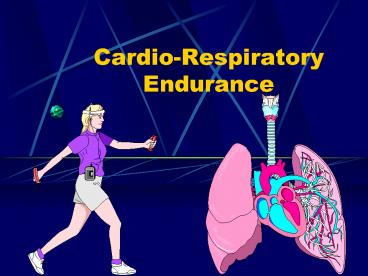CardioRespiratory Endurance - PowerPoint PPT Presentation
1 / 30
Title:
CardioRespiratory Endurance
Description:
Cardio-Respiratory Endurance (CRE, CVE, Aerobic Endurance) The best indicator ... The most important component of physical fitness and ... Lance Armstrong: ... – PowerPoint PPT presentation
Number of Views:1642
Avg rating:3.0/5.0
Title: CardioRespiratory Endurance
1
Cardio-Respiratory Endurance
2
Cardio-Respiratory System
- Heart-lung system
- Purpose?
- Gas transport (O2 in and CO2 out)
- Deliver nutrients
- Remove wastes
- Deliver hormones
- Temperature regulation
- Balance body fluids
3
Cardio-Respiratory Endurance (CRE, CVE, Aerobic
Endurance)
- The best indicator of overall health
- The most important component of physical fitness
and health-related fitness
4
(No Transcript)
5
Benefits of Cardio-Respiratory Endurance Training
- Reduces the risk of
- Dying prematurely
- Dying from heart disease
- Developing diabetes
- Developing high blood pressure
- Developing colon cancer
- Increases blood volume
- Increases stroke volume
6
Benefits of Cardio- Respiratory Endurance
Training 2
- Increases VO2
- Decreases resting heart rate
- Decreases recovery time
- Helps control body weight
- Helps maintain and build healthy bones, joints,
and muscles - Improves mobility
- Promotes psychological well-being
7
Benefits of Cardio- Respiratory Training 3
- Reduces depression
- Reduces stress and anxiety
8
Stroke Volume
- The amount of blood pumped from the heart in a
single beat (approx. 70ml)
9
Cardiac Output
- The amount of blood pumped by the heart in a
minute (approx. 5 liters at rest--trained or
untrained) - CO increases with activity 4 to 6 times
- SV X HR CO
- 70ml (SV) x 72 (HR) 5040ml (CO)
- Refer to overhead
10
Components of the CRE Exercise Prescription
- Mode
- Frequency
- Intensity
- Duration
- Progression
11
Modality
- Choose activities that involves
- A large proportion of muscle mass
- Maximizes the use of large muscles
- Minimizes the use of small muscles
- Whole-body, is repetitive, 20-60 minutes duration
(bike, walk, run etc.) - Be quantifiable with respect to intensity
- Enjoyable
12
Frequency
- 3 - 5 days / week (non-symptomatic)
- More or less based on current fitness levels, age
health status, and exercise objectives.
13
Duration
- 20 - 60 minutes for normal, healthy, individuals
- 3 bouts of 10 minutes if very unfit
- Other variables
14
Intensity How Hard
- How hard does your heart have to work to
strengthen it?
15
Intensity
- Typically, 50/60- 85 of ones heart rate
reserve (what the heart is capable of)
(40/50-85) - Must tailor intensity to the individual
- Intensity is inversely related to duration
16
4 Procedures for Establishing Intensity 2
- Heart Rate Reserve Method
- (RPE) Rate of Perceived Exertion
- Maximal Heart Rate (60-90)
- VO2 (Percentage of Maximum Oxygen Consumption)
17
Before Determining CV Intensity
- Should I see a physician prior to beginning a
regular aerobic workout plan? - Lab 1D answered this question
18
Appropriate Intensities (Based onHHR)
- Low fitness 40, 60, 75 of HRR
- Average fitness 60, 75, 85 of HRR
- High fitness 70, 80, 90 of HRR
- Two or more risk factors 50, 60, 70
- Asthmatics 50, 60, 75 of HRR
- Heart Rate Reserve and Rockport Worksheet
19
Recording Information On Your Card
- Record info on your card
- ____ ____BPM /6 ___(10 sec ct.)
- ____ ____BPM /6 ___(10 sec ct.)
- ____ ____BPM /6 ___(10 sec ct.)
20
(No Transcript)
21
(No Transcript)
22
Rate of Perceived Exertion (RPE)
- Appropriate alternative to heart rates
- Recommended when
- pregnant
- taking BP medications
23
Rate of Progression
- Mileage increases from week to week should not
exceed 10 - Specific to individual
24
Rate of Progression 2
- Initial Conditioning Stage
- Improvement Stage
- Maintenance Stage
25
I Want To Become A Jogger
- Determine and monitor HR (intensity)
- Get used to walking regularly at appropriate
intensity - Work up to at least 30 minutes, 3 to 5 times per
week - Walk 5 minutes, jog one minute ... (30 minutes)
26
VO2 Maximum
- Maximum volume of oxygen consumed while
exercising - Indicator of how strong the heart is
- Is measured in ml/kg/min
- Normal VO2 for college age is 38-46 ml/kg/min
- Rockport walk test is an indirect way of
determining VO2 max.
27
VO2 2
- After 25, VO2 declines almost 1 per year
- VO2 potential is genetically determined
- Bed-ridden 3.5
- Lance Armstrong 70 - 80 ml/kg/min
- Some say I just cant get enough air in, it must
be my lungs... Its really related to your
heart!!!
28
If Your Goal Is Weight Loss In Addition To
Strengthening The Heart
- In order to lose weight, caloric expenditure must
be greater than caloric input - Intensity 50/60 - 85
- Frequency Five days per week or more
- Duration 45 minutes or more (due to change in
bodys energy sources) - Mode Walk, run, swim, bike, row machines etc.
29
De-training
- Principle of reversibility
- The body will respond negatively to any form of
detraining
30
Make It Fun!
- Create contests and games
- Keep a log of activity

